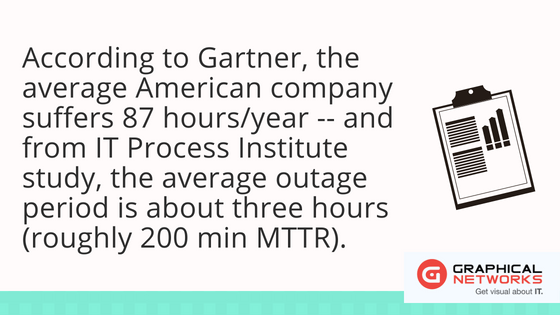 Let’s face it: we all say “network documentation is important”… but for some reason it is never truly considered urgent or a higher priority. I hear it all the time. Yet, when the ‘you know what’ hits the fan, we all go desperately scrambling for those uninspired network documents…only to find them outdated and basically useless.
Let’s face it: we all say “network documentation is important”… but for some reason it is never truly considered urgent or a higher priority. I hear it all the time. Yet, when the ‘you know what’ hits the fan, we all go desperately scrambling for those uninspired network documents…only to find them outdated and basically useless.
So…what’s going on? Why are so many network admins stuck in this cycle? Because…there is always something more urgent to do and we procrastinate.
“If only we could only automate the network diagrams, without costing an arm and a leg.”
Maybe your boss has asked you to look for some automated network diagram solutions. Then, later down the road, you hear, ‘oh our network documentation project was set aside to a later date since it is not a high priority’.
The cycle continues.
If you’re sick of it, here’s some talking points to take to your management to get funding approval and make the bosses see the light on why, exactly, automated network documentation should be a priority.
Not Documenting the Network is Expensive
So…why isn’t network diagramming and documentation a high priority? Are your spreadsheets and Visio diagrams overwhelming and you can’t find the information you can’t find? Are you hiring contractors to drive to remote locations to do site surveys?
When you properly document the network, you can:
- reduce downtime,
- reduce mean time to repair (MTTR),
- reduce expenditures (and locate stranded assets),
- and improve capacity planning.
Next, let’s take a look at each of the above points in detail.
Reduce Downtime
According to Gartner, the average American company suffers 87 hours/year — and from IT Process Institute study, the average outage period is about three hours (roughly 200 min MTTR). Network downtime costs organizations significant amounts of money. Maybe you can’t see the costs from an invoice or spreadsheet, maybe it sounds like an intangible cost you can’t feel or touch, but: it does have a big impact.
Why downtime costs you money:
- Lost revenue from customers
- SLA penalties
- Decreases employee productivity
- Affects company reputation
Reduce MTTR
Your network documentation doesn’t have to be a sophisticated root cause analysis engine…but at a very minimum: it should give you a clear picture of how a component, that is affected by an outage connects from A to Z, how it is connected to the rest of the network and what other systems or services it affects.
With network documentation in place, you can quickly trace outages and get everything back up and running — without wasting your time (and money) trying to find the proverbial needle in the haystack.
Reduce Expenditures
In this blog, we often discuss zombie servers and zombie cables from previous blogs. In fact, I just had a conversation with an organization who found out they still had many Cisco routers running on their network even though they thought they had decommissioned them. I wonder just how much was this costing the organization in both space and power consumption? This is what we call stranded assets.
Why Stranded Assets costs you money:
- Unused network ports
- Underutilized switches and routers
- Cables, circuits
- Extra licenses, applications and beyond
- Power and space consumption
According to analysts, stranded or underutilized networking and IT assets account for 5% to 40% of the IT install base. How about that for an ROI justification!?
Improve Capacity Planning
Without a proper inventory of your IT assets, budget allocation suffers due to lack of data on growth rates. With the proper system in place, you can plan in advance what really needs to be purchased and deployed instead of buying unnecessary hardware, pile up on VMs or allocate extra bandwidth that was never needed to begin with.
Bottomline? Next time the higher-ups say ‘network documentation isn’t a priority right now’, bring the above talking points to the table. If reducing downtime, planning for capacity, saving money, and cutting down on IT waste is a priority…then yes: network documentation is absolutely a priority.
